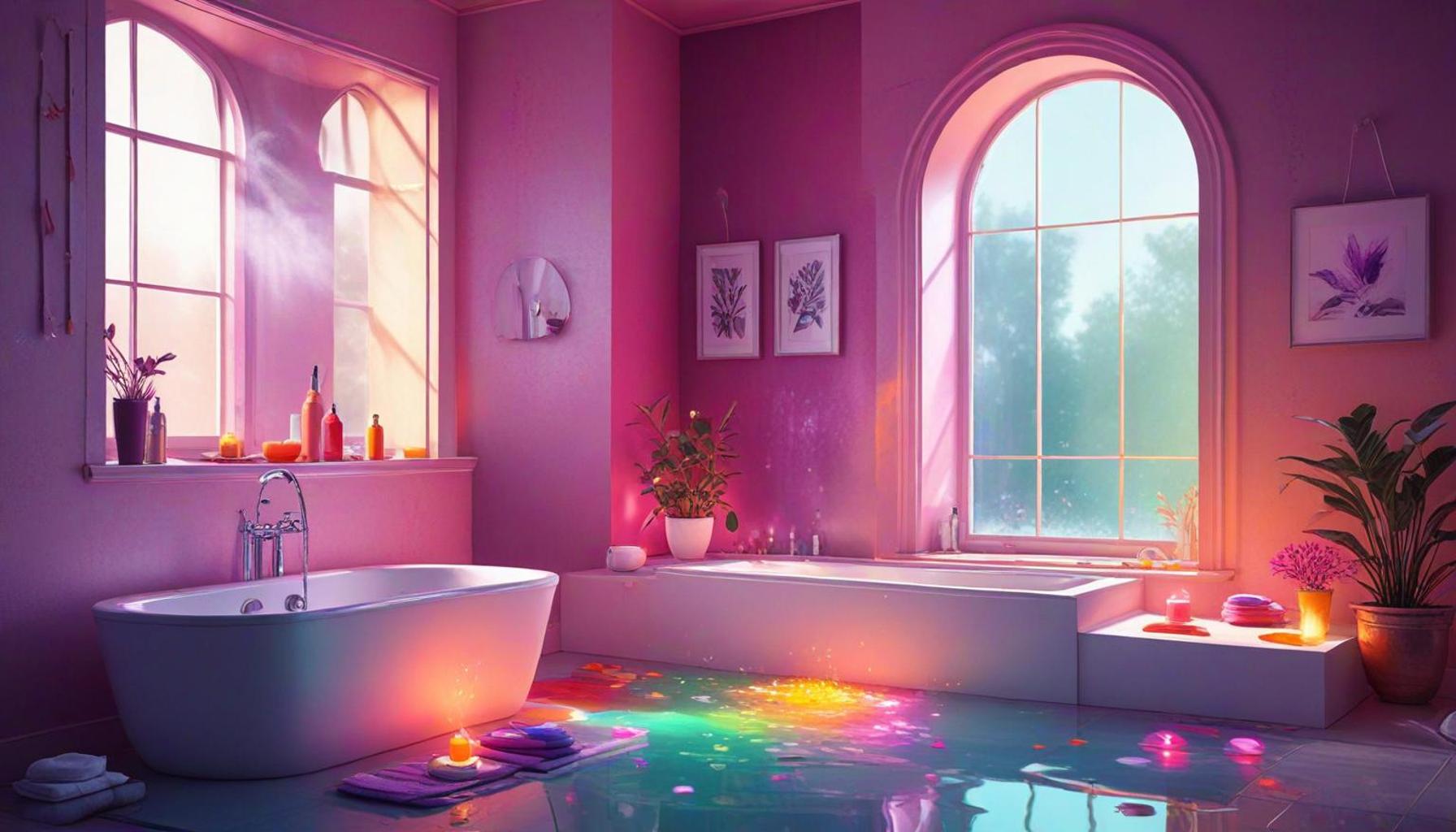Discovering Sensory Consciousness Through Light and Shadow in Bath Meditation

Finding Inner Peace Through Light and Shadow
In today’s increasingly chaotic society, individuals are constantly searching for methods to cultivate a sense of inner calm and wellness. One such innovative practice gaining traction is bath meditation. This technique harnesses the interplay of light and shadow to deepen sensory consciousness, creating a powerful tool for relaxation and introspection.
Why Light and Shadow Matter
The significance of light and shadow in establishing a tranquil meditation space cannot be understated. These elements contribute uniquely to the overall experience, enhancing the atmosphere in which one can reflect and find solace. Here are some compelling reasons why they are critical:
- Enhancing Awareness: Variations in light intensity can influence one’s level of awareness and mindfulness. For instance, soft, diffused light can create a calming effect, while brighter light encourages alertness and focus. In the Nigerian context, employing candles or oil lamps during a bath meditation can mimic traditional settings while providing a gentle glow that enhances mindfulness.
- Create Ambiance: Shadows play a vital role in crafting a mystical atmosphere. The shifting forms cast by candlelight or natural light can stimulate the imagination, prompting deeper introspection. In homes with brick walls and cultural artifacts, the shadows they cast can enhance the ambiance, facilitating a more profound meditative state.
- Sensory Engagement: Engaging visually with the contrasts between light and shadow stimulates cognitive activities. It encourages the mind to wander, leading to self-exploration and reflection. Practitioners can benefit from incorporating elements of the Nigerian landscape, allowing the natural interplay of shadows from palm trees or other indigenous flora to create a captivating setting.
The Rich Experience of Bath Meditation
Bath meditation offers a distinctive avenue for personal exploration by utilizing the sensory experiences tied to light and shadow. As you sink into the soothing warmth of the water, several key aspects contribute to the depth of your meditation:
- Feel the warmth: The enveloping heat of the water complements the mental exploration taking place. Warm baths can increase blood flow and reduce tension, creating an optimal physical state for relaxation and meditation.
- Visual stimulation: Observe how the shadows shift and dance across the walls of your bathing space. This playful interaction can prompt reflections on your thoughts or emotions, encouraging you to delve deeper into self-discovery.
- Soundscapes: The gentle sounds of water splashing can create a soundscape that captures your focus and guides you back to the present moment. In Nigeria, you can enhance this experience by incorporating soft music or the natural sounds of wildlife from outside, blending the auditory and sensory elements for a more immersive meditation.
Incorporating these elements into bath meditation not only nurtures relaxation but also presents an invaluable opportunity to delve into your own sensory consciousness. This practice empowers individuals to reconnect with their inner selves, fostering transformative experiences that can evolve both mind and spirit. Whether you enjoy a quiet moment alone or share the experience with family, bath meditation can become a cherished ritual in the pursuit of harmony and balance.
LEARN MORE: This related article may interest you

The Power of Sensory Experience
When embarking on the journey of bath meditation, it is essential to acknowledge the profound influence that sensory experiences have on our mental and emotional state. By embracing the duality of light and shadow, practitioners can tap into sensory consciousness that transcends mere relaxation, illuminating pathways to self-awareness and introspection. Every aspect, from the temperature of the water to the flickering shadows, contributes to a holistic experience that soothes the soul and sharpens the mind.
Crafting Your Sanctuary
To transform your bathing area into a personal sanctuary, consider how you can carefully manipulate the interplay of light and shadow. Here are some suggestions to elevate your bath meditation experience:
- Natural Lighting: If possible, use natural light to create a calming atmosphere. Sunrise and sunset offer some of the most beautiful and tranquil lighting, casting gentle shadows across your surroundings. In Nigerian cities like Lagos, waking up early for a sunrise bath can provide a serene start to your day.
- Candlelight: Incorporate candles to evoke a warm, welcoming glow. Their flickering flames not only produce soothing shadows but also reflect cultural practices, where lighting candles for relaxation is deeply rooted. Choose scents that resonate with you — perhaps locally sourced essential oils like neem or lemon grass to enhance the sensory experience.
- Reflective Surfaces: Utilize mirrors or water reflections to amplify light and shadow play. This can create a dynamic visual harmony, further engaging your senses. For those who are enjoying bath meditation in rural areas of Nigeria, this might mean taking advantage of outdoor settings where natural reflections from water bodies enhance the ambiance.
Throughout this process, it is essential to maintain an awareness of how these sensory elements affect your mental state. Observe your thoughts as they arise, weaving through the shadows and light in equal measure, ultimately uncovering deeper insights about yourself. Each element combines to foster an environment conducive to meditation, awakening a new level of sensory consciousness.
Self-Discovery Through Introspection
Bath meditation extends beyond the physical experience of immersion in water; it is an opportunity for self-discovery and introspection. The quiet solitude and the gentle caress of water provide fertile ground for profound personal exploration. Each moment spent in the bath can serve as a doorway into the intricate layers of your psyche. Here are a few reflective practices to enrich your meditation:
- Mindful Breathing: Focus on your breath as it flows in and out, synchronizing with the rhythms of the water. This connection can foster a deeper understanding of your inner self.
- Visualization Techniques: As you observe the shifting shadows, imagine them as representations of your thoughts and emotions. Watch how they dance and morph, and allow yourself to let go of what no longer serves you.
- Journaling Post-Meditation: After your bath, take a moment to jot down your thoughts and insights. This practice not only solidifies the experience but also provides a tangible record for your personal growth.
By embracing the tactile and visual components of light and shadow in bath meditation, you open yourself up to an extraordinary journey of sensory consciousness. Each ritual becomes an expression of uniqueness, inspired by your surroundings and personal experiences. Allowing this practice to flourish within a culturally rich framework, such as that found in Nigeria, enhances the transformative potential of your journey toward inner peace.
| Category | Characteristics |
|---|---|
| Light Techniques | Utilizing varying light intensities to enhance focus and relaxation. |
| Shadow Exploration | Understanding the presence and impact of shadows in meditation to promote mindfulness. |
| Emotional Awareness | Cultivating a deeper connection to emotions through sensory experiences. |
| Sensory Integration | The interplay of light and shadow aids in holistic sensory awareness. |
The practice of discovering sensory consciousness through the light and shadow in bath meditation opens an array of cognitive and emotional benefits. By harnessing specific light techniques, practitioners can enhance their focus and relaxation, leading to a profound meditative experience. Moreover, the intentional exploration of shadows deepens awareness, allowing individuals to embrace both light and darkness in their emotional landscapes. Such practices enhance emotional awareness, as individuals learn to recognize and accept their feelings through the lens of their sensory observations. Integrating these approaches contributes to a holistic sensory understanding, promoting mindfulness and self-discovery. Engaging with this fascinating interplay of light and shadow not only enriches meditation practices but guides one toward a more profound awareness of self and environment, inviting a transformative journey.
SEE ALSO: Click here to read another article
Uncovering Emotional Depths Through Light and Shadow
Expanding on the sensory experience of bath meditation, the interplay of light and shadow serves as a catalyst for unraveling emotional depths. In Nigeria, a country rich in diverse cultures, the significance of light can be deeply symbolic, often representing hope, spirituality, and renewal. As you engage with this meditative practice, the profound layers of emotional awareness begin to unveil themselves, drawing connections to both personal and cultural heritage.
The Role of Cultural Rituals
In many Nigerian cultures, rituals that involve water are tied to ancestral practices and healing. The act of bathing, particularly in gently lit spaces, can evoke memories and feelings associated with these traditions. When one engages in bath meditation, it is beneficial to reflect on these connections. Allow the warm glow of candlelight or the soft hues of the setting sun to guide your thoughts toward these rituals. Consider how they resonate with your personal journey and the emotional landscapes they bring up. This layered approach can facilitate deeper understanding and acceptance of your emotions.
Transformative Use of Light and Shadow
As you settle into your meditative state, observe how shadows move across your body and surroundings. This movement can provoke thought; the varying intensities of light and shadow can symbolize the duality of emotions — joy and sorrow, clarity and confusion. Engaging with this dynamic can be enlightening, leading you to consider the balance you seek in your own life. For instance, Nigerians often navigate the complexities of communal vs. individual identity, and this balance can be reflected upon during meditation.
- Shadow Work: Embrace your shadows. Take a moment to acknowledge any unsettled feelings or negativity that may arise. Instead of resisting them, allow yourself to feel and understand them — much like how light and shadow coexist. This practice can help in reconciling parts of yourself that require healing.
- Color Influence: Incorporate colors into your bathing space that evoke particular emotions. For example, warm tones can foster feelings of comfort and safety, while cooler tones can evoke serenity. Experimenting with different colors of light during your meditation can guide your emotional state.
- Music and Sounds: The act of playing soft, soothing sounds or traditional Nigerian music while you meditate can enhance the sensory experience. Traditional instruments, like the talking drum or kalimba, can elevate the ambiance and enliven the shadows and light present in your environment.
This meticulous observation of light and shadow is not merely decorative; it serves a fundamental purpose in elevating your sensory consciousness. Engaging mindfully with these sensory elements allows for a deeper dive into your own psyche, promoting emotional well-being and personal growth.
Finding Freedom in Sensory Expression
Throughout the process of bath meditation, let the sensory elements guide your journey toward freedom. When you acknowledge the sensory consciousness brought forth by light and shadows, you engage in a literal exploration of your feelings and thoughts in a safe space. This sense of liberation can lead you to uncover creative expressions of self, such as art, poetry, or journaling, that may be inspired by your meditative experience.
In the end, acknowledging the power of light and shadow as tools for self-exploration can redefine your approach to bath meditation, anchoring your practice within a rich tapestry of personal and cultural narratives. The culmination of these elements invites you to embrace the full spectrum of your emotional existence, carving pathways to deeper self-understanding.
LEARN MORE: This related article may interest you
Embracing the Journey of Sensory Consciousness
In conclusion, discovering sensory consciousness through light and shadow in bath meditation opens up a transformative path towards emotional exploration and self-awareness. By thoughtfully engaging with the interplay of light and shadow, individuals can dive deep into their emotional landscapes, fostering a connection with their inner self that extends beyond the physical realm. In the context of Nigeria’s rich cultural heritage, the practice resonates on multiple levels—drawing from ancestral rituals and invoking profound symbolism embedded within water and illumination.
The meditative practice harnesses cultural significance, allowing individuals to reflect on personal narratives intertwined with collective traditions. Emphasizing shadow work, color influence, and the incorporation of soothing sounds can significantly enhance the sensory experience, leading to emotional clarity and healing. This ritual encourages a nuanced understanding of the duality of emotions and the delicate balance we navigate in our daily lives.
Ultimately, bath meditation is more than a mere self-care routine—it is a journey toward embracing the full spectrum of our emotional existence. As the flickering light intertwines with the comforting embrace of shadows, we are reminded that our experiences, both bright and dark, contribute to a richer, more profound sense of self. Through this practice, we are empowered to explore, accept, and express our emotions in a safe and nurturing atmosphere, paving the way for profound personal growth.
For those seeking to deepen their connection with themselves and their surroundings, bath meditation offers a unique and enriching exploration of the sensory consciousness that enhances overall well-being. Therefore, it is encouraged to embark on this enlightening journey with an open heart and curious mind, embracing the lessons that light and shadow have to offer.



